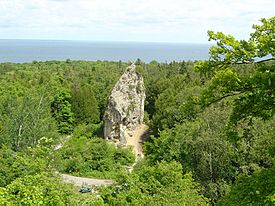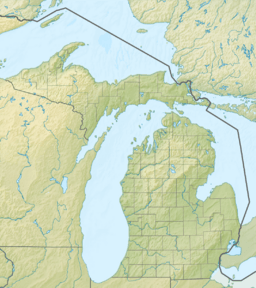Sugar Loaf (Mackinac Island) facts for kids
Quick facts for kids Sugar Loaf |
|
|---|---|

View from Point Lookout
|
|
| Highest point | |
| Elevation | 75 ft (23 m) |
| Geography | |
| Location | Mackinac Island Michigan, United States |
|
Sugar Loaf
|
|
|
U.S. National Historic Landmark District
Contributing Property |
|
| Part of | Mackinac Island (ID66000397) |
| Designated NHLDCP | October 15, 1966 |
Sugar Loaf is a huge rock that stands 75 feet (about 23 meters) tall in the middle of Mackinac Island. This island is located in Lake Huron. Sugar Loaf is like a giant stone pillar that was once part of the island.
This amazing rock was formed a long time ago by water and ice. During the time of an ancient lake called Lake Algonquin, melting glaciers created strong currents. These currents slowly wore away the softer rock around Sugar Loaf. What was left behind was this tough limestone rock, which is the biggest rock formation created by erosion in the Straits of Mackinac.
You can find Sugar Loaf inside the Mackinac Island State Park. It's near where Crooked Tree Road and Sugar Loaf Road meet. You can get a great view of it from a spot called Point Lookout, which is one of the highest places on the island.
Contents
What's in a Name?
The name "Sugar Loaf" comes from how people used to store maple sugar. Long ago, people on the Great Lakes frontier used maple sugar as their main sweetener. They would pack this sugar into cone-shaped baskets. These baskets were often made from birchbark and were called makakoon. Sugar Loaf Rock looks a lot like one of these cone-shaped sugar baskets, which is how it got its name!
Amazing Stories and Legends
Many interesting stories and legends have been told about Sugar Loaf Rock. Both Native Americans and early settlers shared tales about this special place.
Home of a Great Spirit
Some stories say that Sugar Loaf was the home of Gitche Manitou, a very powerful spirit. This shows how important and mysterious the rock was to people.
The Petrified Man
Other legends tell of a man who was punished for being too proud. He broke an important rule or taboo and was turned into a giant stone. People say that a male face can be seen in the limestone on the side of Sugar Loaf Rock. This face is believed to be that of the man who was turned to stone, forever stuck in his new form.
Ancient Resting Places
It seems that Sugar Loaf Rock was also used for special ancient traditions. In 1831, a French visitor named Alexis de Tocqueville came to Mackinac Island. His friend, Gustave de Beaumont, wrote that the rock had "crevices and faults where the Indians sometimes deposed the bones of the dead." This suggests that the rock might have been a special resting place for people long ago. Any such remains have since disappeared.
The Secret Cave
There is also a natural cave that goes right through Sugar Loaf Rock. It's quite small, so only very adventurous children might be able to explore it!


